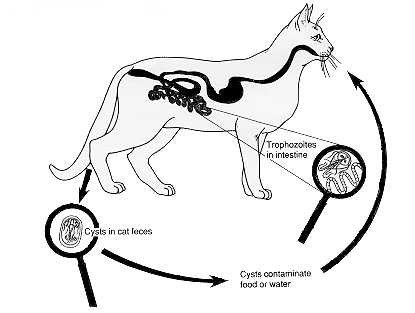| |
Giardia in Cats | |
| |
|
|
| |
|
|
| | [ Life cycle of Giardia | How many species of Giardia are there? | How do cats get Giardia? | Can people get Giardia from a cat? | Are infections harmful to cats? | How to know a cat is infected? | How to treat a cat? ]

Figure 1. Life Cycle of Giardia in Cats
Giardia spp. are single-celled parasitic organisms (protozoa) found in the intestines of cats and many other animals. These microscopic parasites attach to the intestinal wall or swim freely in the mucous lining of the intestine (Figure1).
Approximately four per cent of pet cats in North America are expected to have Giardia. Cats less than three years of age are more often infected than older cats.
Life cycle of Giardia
Giardia occurs in two forms: a motile feeding stage (trophozoite) that lives within the intestine and a non-motile stage. The cyst develops as the parasite is swept down the intestine and before it passes in the feces. Cysts are fully developed when the enclosed protozoan divides to form two daughter organisms. The daughter trophozoites are released when the cysts are accidentally eaten. Once the parasites are released, they increase their numbers by dividing in half repeatedly.
How Many Species of Giardia? are There?
Historically, Giardia was given a different name whenever it was discovered in a new host so that a variety of names were attached to Giardia, e.g. G. bovis in cattle, G. canis in dogs and G. cati in cats. Today, scientists believe that only a few species occur, each capable of infecting more than one host.
How do Cats get Giardia?
Cats become infected with Giardia by eating food or drinking water contaminated with cysts. Streams or other sources of water may also contain cysts. Direct contact between animals may transmit cysts from an infected cat to an uninfected one. Giardia is transmitted more frequently between animals in close quarters, such as kennels, and stray animals are more often infected than pets.
Can People get Giardia from a Cat?
Whether or not Giardia in cats can be transmitted to humans is still controversial. Until scientists resolve this riddle, it is better to assume that it is possible.
Are Infections Harmful to Cats?
Very little research has been conducted in this area. Weight loss and evidence of malabsorption or maldigestion may be found. If the condition persists, the disease may interfere with the way the body absorbs fat, and the feces may have a high fat content. As a result, the cat may have a deficiency in fat soluable vitamins and develop a rough, dry coat and dry skin.
How to Know a Cat is Infected?
Clinical signs of Giardia may include pale, foul smelling feces, chronic diarrhea, weight loss or poor weight gain. Clinical signs are not always present. Infected cats may appear healthy and shed cysts.
A diagnosis of Giardia is confirmed by finding cysts in normal feces or trophozoites in watery stools. Cysts are not shed continuously, so three fecal samples should be examined over a period of seven to ten days to obtain a diagnosis.
How to Treat a Cat?
Quinacrine, metronidazole and furazolidone are a few of the drugs used for the treatment of giardiasis in cats.
Contact your veterinarian for advice on drug selection and treatment programs. Infected animals showing clinical signs should be treated.
Prepared by:
Dr. Murray Kennedy - Food Safety Division
Source: Agdex 655-6. Revised April 2001. |
|
| |
|
|
| |
For more information about the content of this document, contact Daniel Fitzgerald.
This document is maintained by Jennifer Rutter.
This information published to the web on April 1, 2001.
|
|